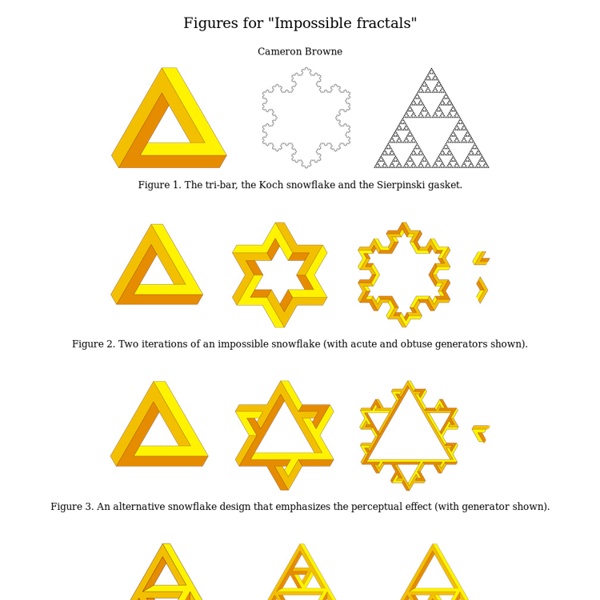



http://www.cameronius.com/graphics/impossible-fractals-figures/
Related: à liquiderTHE SECRET LIVES OF NUMBERS The authors conducted an exhaustive empirical study, with the aid of custom software, public search engines and powerful statistical techniques, in order to determine the relative popularity of every integer between 0 and one million. The resulting information exhibits an extraordinary variety of patterns which reflect and refract our culture, our minds, and our bodies. For example, certain numbers, such as 212, 486, 911, 1040, 1492, 1776, 68040, or 90210, occur more frequently than their neighbors because they are used to denominate the phone numbers, tax forms, computer chips, famous dates, or television programs that figure prominently in our culture. Regular periodicities in the data, located at multiples and powers of ten, mirror our cognitive preference for round numbers in our biologically-driven base-10 numbering system. Certain numbers, such as 12345 or 8888, appear to be more popular simply because they are easier to remember.
State Political Directorate The Joint State Political Directorate (also translated as the All-Union State Political Administration) was the secret police of the Soviet Union from 1922 to 1934. Its official name was "Joint State Political Directorate under the Council of People's Commissars of the USSR" (Russian: Объединённое государственное политическое управление при СНК СССР), Obyedinyonnoye gosudarstvennoye politicheskoye upravleniye under the SNK of the USSR, or ОГПУ (OGPU). With the creation of the USSR in December 1922, a unified organization was required to exercise control over state security throughout the new union. Thus, on November 15, 1923, the Russian State Political Directorate left the Russian NKVD and became the all-union Joint State Political Directorate. Felix Dzerzhinsky, chairman of the GPU, became the OGPU's first chief. Like the GPU before it, the OGPU was theoretically supposed to operate with more restraint than the original Bolshevik secret police, the Cheka.
technuevo fractal world gallery fractal world gallery pure flame fractals, fractal flame composites, fractals, etc.www.enchgallery.com Tech Nouveau fractal flame composite by Cory Ench © 2007LAST NEXT fractal world thumbnails 2 + 2 = 5 History[edit] Victor Hugo and Fyodor Dostoyevsky[edit] In Fyodor Dostoyevsky's Notes from Underground, the protagonist implicitly supports the idea of two times two making five, spending several paragraphs considering the implications of rejecting the statement "two times two makes four." His purpose is not ideological, however.
The Marijuana Trick And I will raise up for them a plant of renown, and they shall be no more consumed with hunger in the land. – Ezekiel 34/29 Where did the word ‘marijuana’ come from? In the mid 1930s, the M-word was created to tarnish the good image and phenomenal history of the hemp plant…as you will read. Nadsat 'Quaint,' said Dr. Brodsky, like smiling,'the dialect of the tribe. Do you know anything of its provenance, Branom?' Crimes Against Humanity Having been conditioned your entire lives, the way we are all conditioned our entire lives, to receive sound-bite answers to questions we have never had the critical ability to form in our minds, forecloses our ability to interrogate reality and draw conclusions from it. That is the function of the media. That is the function of the educational system you understand. It's not to teach you to think critically, which is educational in value. It's to teach you what to think. That's indoctrination.
Linguistic relativity The principle of linguistic relativity holds that the structure of a language affects the ways in which its respective speakers conceptualize their world, i.e. their world view, or otherwise influences their cognitive processes. Popularly known as the Sapir–Whorf hypothesis, or Whorfianism, the principle is often defined to include two versions: Strong version: that language determines thought and that linguistic categories limit and determine cognitive categoriesWeak version: that linguistic categories and usage influence thought and certain kinds of non-linguistic behaviour. The term "Sapir–Whorf hypothesis" is a misnomer, because Edward Sapir and Benjamin Lee Whorf never co-authored anything, and never stated their ideas in terms of a hypothesis. Definitional issues and debates[edit] The concept of linguistic relativity holds that cognitive processes, such as thought and experience, may be influenced by the categories and patterns of the language a person speaks.